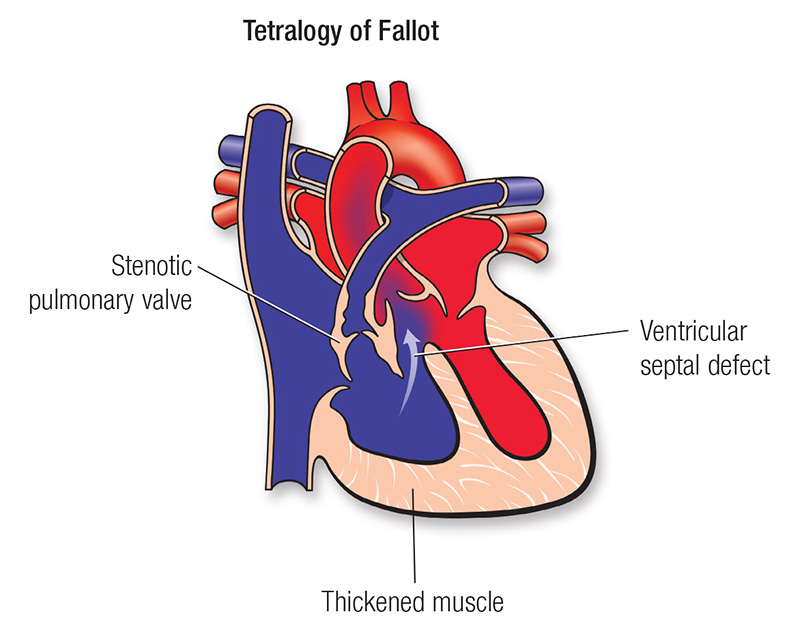Fallot’s Tetralogy: Symptoms, Causes, Treatment
What are the symptoms of Fallot’s tetralogy?
Tetralogy of Fallot (ToF) is a congenital heart defect that is present at birth. It involves four specific heart defects that affect the structure of the heart and the flow of blood through the heart and lungs. The four defects that make up Tetralogy of Fallot are:
- Ventricular septal defect (VSD): A hole in the wall (septum) that separates the two lower chambers of the heart (ventricles). This allows oxygen-poor blood from the right ventricle to mix with oxygen-rich blood from the left ventricle.
- Pulmonary stenosis: Narrowing of the pulmonary valve or the area between the pulmonary valve and the pulmonary artery, which reduces blood flow to the lungs.
- Right ventricular hypertrophy: Thickening of the muscle of the right ventricle, which occurs in response to the increased workload of pumping blood through the narrowed pulmonary valve.
- Overriding aorta: The aorta, the main artery that carries oxygen-rich blood from the heart to the body, is shifted slightly to the right and lies directly over the ventricular septal defect.
Symptoms of Tetralogy of Fallot can vary depending on the degree of pulmonary stenosis and the size of the ventricular septal defect. Common symptoms may include:
- Cyanosis: Bluish tint to the skin, lips, and nail beds due to low oxygen levels in the blood (cyanotic spells or “tet spells” can occur, especially during crying or feeding).
- Shortness of breath or rapid breathing: Especially during feeding or exertion.
- Fatigue or poor weight gain: Due to the heart having to work harder to pump blood.
- Clubbing of the fingers and toes: Enlargement of the tips of the fingers and toes due to chronic low oxygen levels.
- Fainting (syncope): Due to reduced blood flow to the brain.
- Heart murmur: A whooshing sound heard through a stethoscope, caused by turbulent blood flow through the defects.
- Delayed growth and development: Due to chronic low oxygen levels.
- Polycythemia: An increase in the number of red blood cells, which can thicken the blood and increase the risk of blood clots.
Symptoms of Tetralogy of Fallot typically appear during infancy or early childhood, but the severity of symptoms can vary widely. Early diagnosis and treatment are important to manage symptoms and prevent complications. Treatment may include surgery to repair the defects and improve blood flow through the heart and lungs.
What are the causes of Fallot’s tetralogy?
Tetralogy of Fallot (ToF) is a congenital heart defect, meaning it is present at birth. The exact cause of ToF is not known, but it is believed to result from a combination of genetic and environmental factors. Some factors that may contribute to the development of ToF include:
- Genetic factors: ToF can run in families, suggesting that there may be a genetic component to the condition. However, the specific genes involved in ToF are not yet fully understood.
- Chromosomal abnormalities: ToF is sometimes associated with chromosomal abnormalities, such as Down syndrome, which can affect heart development.
- Maternal factors: Some studies suggest that certain maternal factors, such as maternal diabetes or exposure to certain medications or chemicals during pregnancy, may increase the risk of ToF. However, more research is needed to fully understand these associations.
- Environmental factors: Exposure to certain environmental factors during pregnancy, such as infections or toxins, may increase the risk of ToF. Again, more research is needed to understand these potential associations.
It’s important to note that in many cases, the exact cause of ToF is unknown, and the condition may occur sporadically without a clear family history or known risk factors. ToF is one of the most common congenital heart defects, affecting approximately 3 in every 10,000 live births. Early diagnosis and treatment by your healthcare provider are important to manage symptoms and improve outcomes for individuals with ToF.
What is the treatment for Fallot’s tetralogy?
The treatment for Tetralogy of Fallot (ToF) depends on the severity of the condition and the specific defects present. Treatment may involve a combination of medications and surgical procedures to improve blood flow through the heart and lungs. Common treatments for ToF include:
- Surgery: Most individuals with ToF will require at least one surgical procedure to repair the defects. The most common surgery for ToF is called a “complete repair,” which is typically performed in early infancy. During this procedure, the ventricular septal defect (VSD) is closed with a patch, and the pulmonary valve is widened or replaced to improve blood flow to the lungs.
- Medications: Medications may be prescribed to manage symptoms and improve heart function. Common medications include diuretics to reduce fluid buildup, beta-blockers to control heart rate and blood pressure, and medications to prevent arrhythmias (abnormal heart rhythms).
- Follow-up care: Regular follow-up with a cardiologist is important to monitor heart function and check for any complications. Additional surgeries or procedures may be needed as the child grows and develops.
- Lifestyle modifications: In some cases, lifestyle modifications may be recommended, such as avoiding strenuous physical activity or certain medications that can affect heart function.
- Palliative procedures: In some cases, particularly in infants who are not candidates for complete repair, palliative procedures may be performed to improve blood flow and relieve symptoms. These procedures are temporary and are usually followed by complete repair at a later time.
The outlook for individuals with ToF has improved significantly in recent years due to advances in surgical techniques and medical management. With appropriate treatment, most individuals with ToF can lead relatively normal, active lives. However, long-term follow-up is important to monitor for any complications and ensure ongoing care.




